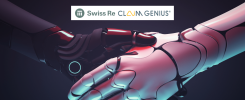Introduction – structure of ANNs, artificial neurons, feedback, bias
Artificial intelligence is notoriously known to follow the thought processes and thinking patterns of real humans, mimicking our methods of learning, matching our abilities of decision making. While the technology that goes behind perfecting AI is complex and a little convoluted, understanding AI becomes a whole lot simpler if you just map each AI function to the human brain.
Artificial neural networks, artificial neurons, feedback, bias… when you understand the parallels in the human brain and AI, you’ll realize, “Hey, they’re just like me!”.
In this blog, we will explore how AI: absorbs and processes information, learns, adapts to new circumstances, and evolves on its own. Just like regular people.
Information Processing
The bedrock of AI is the ANN / artificial neural network. An ANN is composed of several layers of neurons. These neurons are interconnected, forming chains consisting of input neurons, middle layers and output neurons.
The more complex the layers in an ANN, the more complex data an AI can process.
These layers, understandably, don’t flow in a linear direction. Layers in an ANN can pass information back to the previous layers, which is very naturally termed as feedback. Every input provided to an ANN passes through a bias, a meter that adjusts the input values.
Data travels through an ANN, sometimes multiple times, until the AI has absorbed the information, and can now proceed to churn the data into valuable information.
Now think of the human brain. The neuron is a very stark metaphor, having direct correlation with human neurology. ANNs are the technological equivalent of the brain itself. Just like we determine right and wrong, pain and pleasure, feedback enables an ANN to qualitatively assess the data it is fed to glean insights from it. The bias quantifies the input, allows us to move past 0s and 1s to qualitative, graded measures.
The human world rarely fits into a string of yeses and no’s, black and white. A cup of coffee doesn’t have to be hot or cold. It can be lukewarm. It would be somewhat wrong to mistake a duck for an amphibian, but very wrong to mistake it for a jazz player. There are levels to the way we measure things, a habit which AI needs to incorporate if it has to achieve near-human performance.
Learning
So, how does an AI learn? Starting out, AI is completely reliant on the data you feed to it. This data is called a ‘data set’. The more accurate the data sets, the better throughput the AI will offer.
Learning in AI is classified broadly into two categories:
In supervised learning, an AI engineer or data scientist ‘walks’ the AI through the data sets and instructs it how to interpret it and formulate rules of evaluating the data. Supervised learning helps AI to deal with missing or erroneous values in the data, and to account for extremities.
Sometimes, after purifying the data, it can be fed to the AI. The AI is then left alone to churn it, process it, and come to its own conclusions. This is the unsupervised mode of AI learning.
Now consider how we as humans learn. Initially, we need education and teaching to learn the basics. As we grow older and our knowledge increases, we become capable of absorbing more complex information. After years of studying and edification, we are finally left alone to put the knowledge we’ve acquired to practical use. Out in the real world, our ability to interpret situations and apply our knowledge helps us solve complex problems, successfully do our jobs and makes our lives easier.
Adapting
It’s a very high expectation to get everything right the first time. That’s one of the best characteristics of the human brain. It does not stop functioning when mistakes are made. It uses the knowledge to:
- Analyse why the mistake was made
- Store the information for later use
- Prevent making the same mistake again by sending ‘warning signals’ when the same scenario is about to be repeated
Of course, these processes happen in a split second and subliminally. Also, you don’t always need to experience something, understand it’s a mistake, and then refrain from committing it again. Most of us have never inserted our fingers into an electric socket. We didn’t need first-hand experience to know that’s dangerous.
Silly as it sounds, it broaches upon an important concept in AI. The ability to glean from the data valuable interpretations that weren’t explicitly fed to the intelligence. Especially with an unsupervised mode of learning, AI’s ability to record past mistakes, learn from its environment and adapt is an invaluable technological marvel.
AI does so by mapping input to output. If the two don’t match, AI understands an error was committed and stores it in its data structures. Next time, AI doesn’t do the same processing on the same input as last time because it has grown ‘wiser’.
Evolving
AI and bots are sometimes used interchangeably. That’s not entirely accurate. A bot does automate things. But AI’s purpose is not just automation, it goes beyond. Bots have the ability to repeat the same task again and again and again but their actions are restricted to what they were programmed to do. However, AI can evolve. It can do better. It can learn new skills, take on new tasks that it wasn’t trained for. Naturally, whether it can perform these tasks well depends on the quality of your data.
Understanding the inherent human need to get better is crucial to understanding AI. There are complex philosophical ideologies on this (for e.g., Abraham Maslow’s Pyramid of Needs). But we don’t even need to dig so deep. Even in our daily routines, we are striving to gain expertise from repetition and get a little better at performing the tasks at hand. 10 push-ups today, 12 tomorrow. Half an hour to write 100 lines of code today, 15 minutes in a week’s time. You get the idea.
By increasing the complexities of ANNs, AI can lean on feedback and biases to mimic this behaviour. AI needs to be able to get better without human intervention. Otherwise, it will always be an overhead on AI engineers to update their AI algorithms when a new scenario comes along, defeating the very purpose of AI.
How Claim Genius Implements AI
We use our AI to make auto-insurance a better, more technologically advanced industry. By understanding AI, we have recognized the pain points of the auto-insurance industry, and deployed our AI at the right places. Be it damage detection, or claim settlement. Our AI can analyse vehicle damage, generate reports, and arrive at quick decisions on whether the accident vehicle needs is repairable or a total loss. By clicking quick snaps on your phone, you can send accident site photographs straight to our intelligence via our AI mobile app. Faster turnaround times in the insurance investigation process means your customers get back on the road faster, thus driving efficiencies and better customer satisfaction.
Contact us with your requirements, and we can get started on working on the perfect AI solution for your needs.


